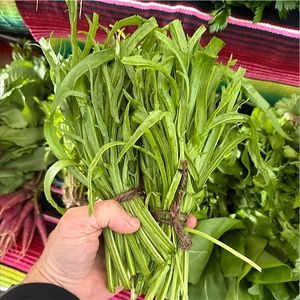


Minutina Greens
Estimated Inventory, lb : 0
Description/Taste
Minutina grows in a loose rosette pattern with upward shooting leaves that reach approximately 30 centimeters long. They are slender and spiked with forking antler-like horns, hence the name “buckshorn”. Minutina’s affinity for growing in saline soils translates into a unique salty flavor on the palate. The leaves have a crisp yet succulent texture with a flavor likened to a cross of spinach and parsley.
Seasons/Availability
Minutina greens are available from mid-fall through early spring.
Current Facts
Minutina is a hardy Italian green that is botanically classified as Plantago coronopus, and a member of the plantain family. It is a relative of broadleaf plantain and may also be commonly referred to as Buckshorn (pronounced bucks-horn) plantain or Erba Stella, meaning “star herb” referring to the plant’s star-shaped growth pattern.
Nutritional Value
Minutina contains tissue healing, cooling and diuretic properties. The leaves are commonly processed and prepared as an ointment or poultice. In the Canary Islands, it is used to treat kidney and urinary disorders.
Applications
Minutina is a hardy green that may be used fresh or cooked. The leaves should be harvested before flowering occurs because the greens can develop a bitter quality. The new young shoots of the plant are tender and best reserved for raw applications, while larger leaves become fibrous with a sharp flavors that require cooking to soften. Use Minutina in salads and stir fries for texture and salinity. Minutina was used in fancy jellies in America and England during Colonial times. Complimentary flavors include feta cheese, parmesan, garlic, lemon, balsamic vinegar, pears, apples, browned butter, sesame oil, seafood and poultry.
Ethnic/Cultural Info
The leaves of Minutina are sometimes used in the traditional Italian salad called misticanza, which translates to “wild greens”.
Geography/History
Minutina is native to the Mediterranean coasts of Europe and Northern Africa, though today it can be found growing world-wide. It was first recorded in Italy in 1586 as a vegetable and was typically used in salads. During Colonial times in America the greens were used for medicinal purposes to treat fevers. The Italian heirloom can withstand mild frosts and grows during the winter in most temperate climates and those with maritime influences.
Recipe Ideas
Recipes that include Minutina Greens. One
| Loam Agronomics |
|
Crispy Chicken Cutlet with Minutina Zhug and Ranch |








